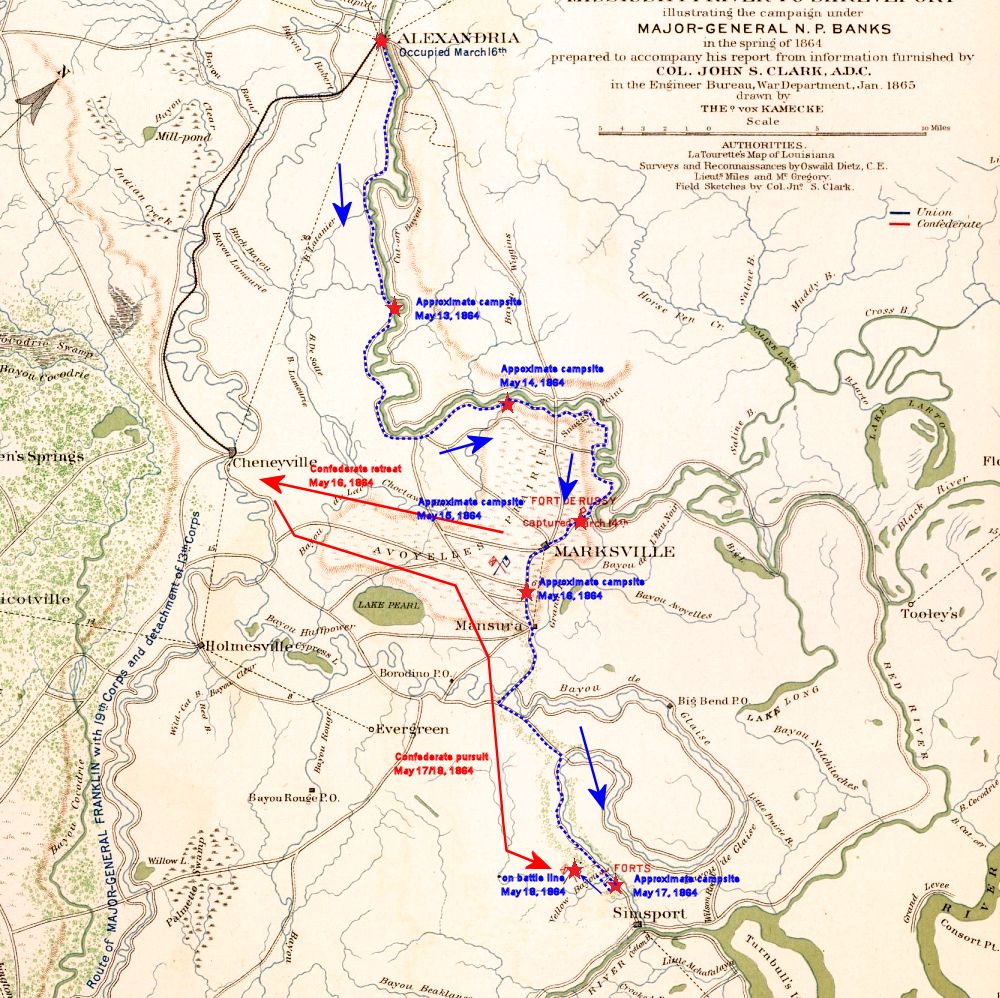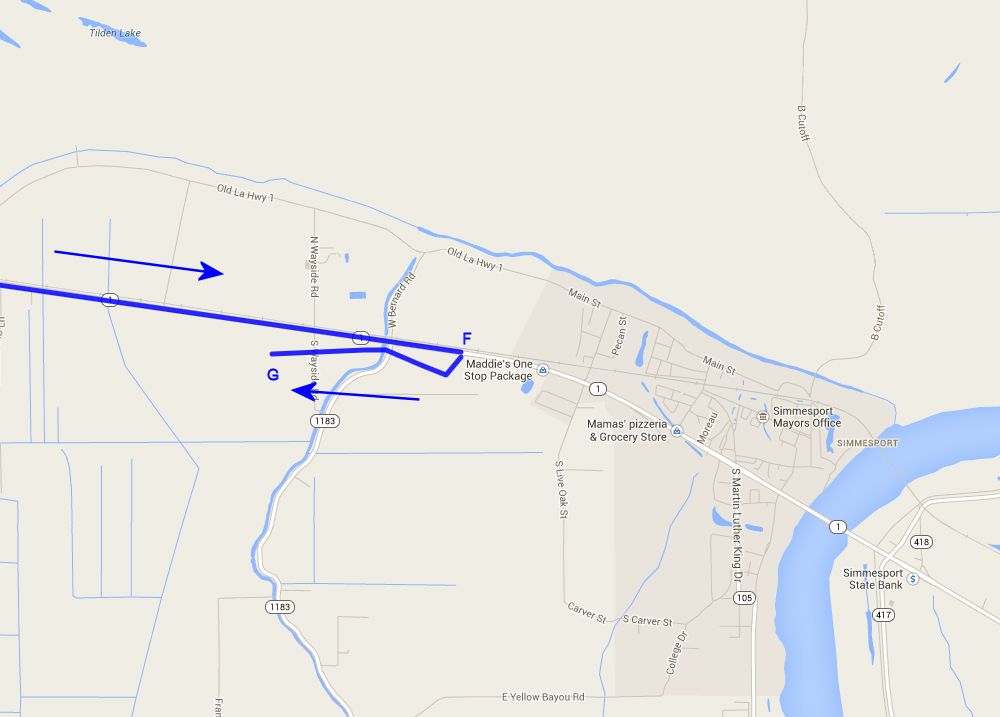| Previous Date | Day By Day Index | 16th OVI Home Page | Next Date |
Where was the regiment on
Wednesday, May 18, 1864
On this day, the front of Union General Nathaniel Banks' retreating column had reached the Atchafalaya River. The column was halted while Lt. Col. Joseph Bailey and his engineers built a pontoon bridge over the river. Banks learned that the forces of Confederate General Richard Taylor had followed the rear of his column and were at or near Yellow Bayou.He ordered Gen. A. J. Smith and his rear guard to stop Taylor's advance. Smith asked Gen. Joseph A. Mower to engage the Confederates. Mower attacked the Rebels, forcing their advance back to their main line. The Rebels counterattacked and the Federals were forced back, but eventually, Mower's troops repulsed Taylor back, effectively ending his pursuit of the Union retreat.
The Battle of Yellow Bayou was the last of the Red River Campaign. The 16th Ohio played a supporting role in this battle, and, with its brigade, was ordered back across Yellow Bayou and up to the front (facing north) to help Gen. Mower's troops guard against additional enemy attack. Pvt. Peter Perrine describes the day:
About 10 A.M. the Enemy attack Genl. A. J. Smith but they find more than an equal match. The fighting was prety severe untill 4 P.M. Our loss is over 200 killed & wounded. The loss of the enemy was much greater than ours. Genl Smith took 250 prisoners. Our Brigade was ordered to the front and lay in line of battle all night...
Cpl. Theodore Wolbach provides a much more colorful description of the battle:
The first dawn of the 18th brought with it the customary shots. As the morning advanced the firing waxed warm and the accompaniment of artillery was frequent. Notwithstanding the many repulses of his soldiers, Dick Taylor determined to strike our rear a hard blow. Accumulating a force of overwhelming strength he advanced and struck our cavalry furiously, cutting off and almost annihilating a portion of the 2d Louisiana loyal cavalry. A desperate charge was made by the 1st Rhode Island, in which sabres and revolvers were freely used, yet this only checked the determined foe temporarily.
Our men fought well, though every collision seemed to force them back a little. Bullets are beginning to come singing over to us from the rebel lines. More troops must be sent over there and that quickly too. Smith's men got orders to fall in and away they start, light-hearted and enthusiastic. Little regiments that one commissioned officer could handle without inconvenience; regiments that have left more dead on a single battlefield than the living ones present number to-day. In looking down through the vista of memory the soul is filled with pride and we almost raise our hats to the inspiring example of these gallant men of the North and the West, who have but a few weeks or months perhaps to serve yet, marching into the jaws of death, into the mouth of hell. Over the pontoons and up to the plateau they form and advance. With a wild rush, never waiting to dress a line, they pass the hard-pressed men of the rearguard, whose faces stained with sweat and powder look horrid in the gloomy shadows of the cypress forest. Brawny Texans, brown-skinned Louisianians, and men from the Arkansas wilds led by officers of undisputed courage were slowly advancing, half crouching with the steady tread and keen eye of the panther hunter, looking for the plucky Federal rearguard, who they intuitively know were waiting with loaded carbines for the reappearance of the foe. Suddenly the hunter becomes the hunted. The blue cyclone sweeps unheralded and with mad velocity down on the slouched hats and glaring eyes of the rebel horde. A few shots followed in an instant by a terrific crash, and Smith's veterans were right in the midst of the Confederates. It was not the admirable charge of the regular in which Hardee's manual and the cadence of step was observed, but it was the rush of devils in which each individual expects to do his utmost. Around trees, over logs and through thickets of weeds, rank as undergrowth, Smith's men shot and pounded their way. Men with blood trickling from their faded clothing kept up the battle yell until their voices failed. Some with wounds that would send many a soldier to the rear on a stretcher, fought on. It was a combat of determined men--of short duration. The Confederates doggedly fell back, then rapidly retired, leaving over five hundred killed, wounded and prisoners behind. Our brigade follows after Smith for support.
The 16th Ohio and the troops defending the rear suffered a very uncomfortable night in an insect-infested forest. Wolbach concludes his description of this day:
The Confederates seemed to be pretty well punished and did not disturb us during the night that was long and uncomfortable to the boys in the forest.
This period military map shows the approximate route taken by the 16th Ohio and other troops under Gen. Nathaniel Banks as they evacuated Alexandria, Louisiana, heading south and east along the Red River. The small blue arrow shows the approximate route of the 16th Ohio when it was ordered to the rear to support Gen. Joseph Mower, shortly after Mower turned back the Rebel attackers. The 16th Ohio spent the nigh on the battle line with Mower's troops, guarding against another attack.
Note that original military attributions on the map reflect the earlier routes of Gen. Banks when he first marched up the Red River in an attempt to capture Shreveport, Louisiana.

Modern day map showing the estimated route and location of the 16th Ohio on its march from Alexandria, Louisiana, southeast along the Red River toward the Mississippi River, retreating from the attacks of Confederate General Richard Taylor.
F - Approximate location of the 16th Ohio when it camped for the night of May 17, 1864, just east of Yellow Bayou, Louisiana.
G -Approximate location of the 16th Ohio when it camped on the battle line of the Battle of Yellow Bayou, on the night of May 18, 1864.

| Previous Date | Day By Day Index | 16th OVI Home Page | Next Date |